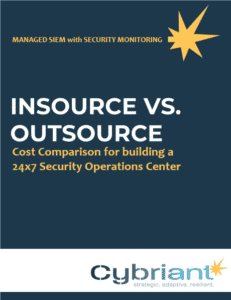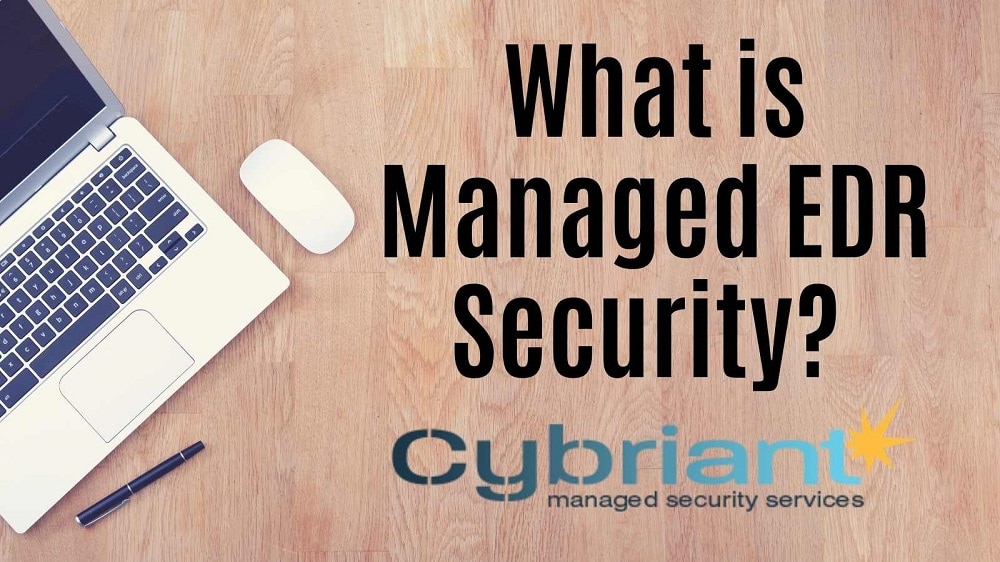Managed EDR Security is more important now than it ever has been. Here are our top guides and recommendations for managed endpoint detection and response.
Update: As technologies have evolved, our EDR service is now called Managed Detection and Remediation. Find out more at cybriant.com/mdr.
EDR, or endpoint detection and response, is a type of security software that helps protect individual devices on a network. It does this by monitoring activity and looking for patterns that may indicate an attempted or successful breach. If a suspicious event is detected, EDR can take action to block it or contain it.
EDR systems are typically deployed as part of a broader security solution, such as an intrusion detection and prevention system (IDPS) or a managed security service. They can also be used on their own, though this is less common.
EDR software is designed to complement other security solutions, not replace them. It’s important to have multiple layers of security in place to protect against the full range of threats.
EDR, or endpoint detection and response, is a type of security software that helps protect individual devices on a network. It does this by monitoring activity and looking for patterns that may indicate an attempted or successful breach. If a suspicious event is detected, EDR can take action to block it or contain it. EDR systems are typically deployed as part of a broader security solution, such as an intrusion detection and prevention system (IDPS) or a managed security service. They can also be used on their own, though this is less common.
What is EDR Security?
EDR Security is a type of cyber security that uses EDR technology to protect devices on a network. EDR systems are deployed as part of a larger security solution, such as an IDPS or managed security service. EDR software is designed to complement other security solutions, not replace them. EDR Security is an important layer of security that should be used in conjunction with other security solutions to protect against the full range of threats.
Endpoint Detection and Response (EDR) is defined as a set of cybersecurity tools that are designed to detect and remove any malware or any other form of malicious activity on any endpoints connected to your network.
Endpoints are attackers’ favorite targets. They are the weakest link in your company’s network. It was recently reported that the WannaCry attack exposed the vulnerabilities of 230,000 endpoints around the world. To this end, installing an endpoint detection and response or EDR is a VITAL aspect of cybersecurity for every company that needs to be proactive to modern-day threats.
Endpoint Detection and Response Definition or EDR Definition
EDR or Endpoint Detection and Response is primarily a technology that brings a proactive approach to the issues of cybersecurity. Most traditional products are reactive to security threats—that is not the case with EDR. EDR security does a great job at monitoring endpoints in real time, hunting for threats that have found their way into the company’s defenses. You’ll also get greater flexibility as regards the happenings on endpoints and even the mechanism to help mitigate the attacks.
One of the common tactics synonymous with cybercriminals is the compromise of endpoints, which enables them to create a foothold on the network. With rapid detection and subsequent response to such attacks targeting hosts— laptops, desktops, and servers– you can be a step ahead in securing your IT infrastructure.
Managed detection and response security is a service that exists because organizations need resources to take into cognizance risks and also improve their ability to detect and respond to threats.
Companies have a set of tools and procedures that they employ in the detection and response to threats. But all MDR come with similar characteristics:
- MDR is more concerned with threat detection, instead of compliance.
- Services are delivered by using the tools and technologies of the provider—but deployed on the premises of users.
- MDR is highly dependent on security event management and also advanced analytics
- MDR is associated with incident validation and remote response.
Why Choose Managed Endpoint Security?
With the level of cybersecurity breaches, your company’s ability to detect and respond to threats is critical. Lacking the complete picture of what is going on across your environment, might put you in a vulnerable position when a threat surfaces.
Managed EDR Security Benefits
- Improving detection capabilities—not just network-based monitoring
- Identify threats beyond traditional preventative security
- Finding the root cause of attacks quickly and effectively
- Looking out for threats with suspicious behavioral patterns
- Separating infected hosts from a network
Endpoint Detection and Response Vendors (EDR Vendors)
Some of the more well-known EDR vendors include SentinelOne, CrowdStrike, Carbon Black, and Symantec. Each endpoint detection and response vendor is a company that provides software or services to help organizations detect, investigate, and respond to malicious activity on their networks.
Cybriant utilizes the SentinelOne platform which specializes in the detection and prevention of ransomware attacks. Together, we offer a 24×7 service along with a platform that can identify malicious activity, including ransomware, and automatically take action to stop it. Plus, our security analysts can stop any malicious activity in its tracks before it can do any harm.
What Is The Difference Between EDR and Antivirus?
Technology is increasingly becoming sophisticated, and cybercriminals are also getting better at their game to keep up. Cyber threats are evolving, and antivirus no longer has the same level of protection it once did—detecting suspicious activity and also protecting your device against malware. Cybercriminals are deploying advanced threats to get ahead in this game. Verizon’s 2017 Data Breach Investigations Report puts it that over half of the breaches are malware related, and after one year, their 2018 Data Breach Investigations Report records only 31% as the included malware.
It then becomes expedient to actively monitor behavioral events at the endpoint level, which is now the new standard. Using EDR security in conjunction with AV allows you to detect abnormal behavior, including an excellent indicator of compromise which the AV solution is not capable of detecting.
Read more: Traditional Antivirus vs. EDR.
3 Types of Attacks That AntiVirus Will not detect
- Zero-day attacks
It is as good as it sounds; it opens up as soon as the weakness is established in AV protection. Hence, before a fix is done, it is exploited. AV may detect a malware signature (continuous sequence bytes that is within the malware), but with a zero-day attack manipulation, sneaking past traditional AV is an easy feat.
- Ransomware attacks
Ransomware attacks deal with software downloaded with the help of an unsuspecting victim through an email attachment that has been infected—like a Microsoft word document. AV cannot protect against ransomware; sometimes it is difficult for the signature of malware to be recognized.
- Fileless malware attacks
Fileless malware attacks happen on existing Windows tools instead of malicious software that is installed on the victim’s computer. As a result, the AV has no signature to pick on.
There are even more advanced threats that antivirus will not detect. Read more here.
Why is EDR Important?
Effective EDR includes the capabilities given below:
- Prevention of malicious activities
- The threat to data exploration or hunting
- Detection of suspicious activities
- Alert suspicious activity or triage validation
- Incident data investigation and search
Read more
Managed EDR solutions are used to detect and assess any suspicious activity on the network endpoints. It is becoming a preferred resource for most enterprises for ensuring their network security. It’s important to consider EDR as well as SIEM, and they work better together.
The reasons which make EDR important for businesses are as follows:
Proactive Approach
With the increasing dependence of technology on businesses, the digital perimeter of companies is expanding very fast. The approach of reactive management of cyber threats and security issues for the network is no longer a prudent strategy.
The current approach is to identify cyber threats and potential attacks before they occur and take remedial actions immediately. EDR solutions are best suited for this approach of proactive management of cybersecurity threats to your network.
Why is EDR important? It can help you detect even malware that has polymorphic codes that keep evolving on its own and take suitable corrective action. Traditional antiviruses are no longer suitable for providing security to your network as hackers have become smarter and devised malware and threats which can easily bypass antiviruses.
Better Data Monitoring and Management
EDR solutions are designed in such a manner that they can collect and monitor data on each of the endpoints on a network. They collect and monitor data about potential cybersecurity threats to the network. The data is collected and stored in the form of a database on endpoints.
The stored data can be further analyzed for determining the root cause of any security issues and also for detecting any potential cyber threat. Collection, monitoring, and analysis of such high-quality forensic data also help in preparing a superior incident response and management strategies.
Read more about Why Is EDR Important.
Regardless of the kind of malware or virus introduced, EDR security cares less—only cares about the existing behavior. If behavior indicates suspicious activity, EDR will immediately send an alert having identified it. The monitoring of indicators that give a sense of malicious activity will continue to protect against further threats.
AV protection cannot be relegated to the background, but combining it with EDR gives a depth approach as regards your overall security apparatus.
Managed EDR Security to boost Existing Security
MDR is offered to augment the existing security infrastructure and also contain threats that could bypass traditional control. Threats such as network attacks, fileless malware, targeted attacks, etc., are fashioned in such a way that it is difficult to detect.
Most organizations are more concerned with where the threat enters and exit the network. But most often than not the lateral movements of threat is less attended to when they enter the system.
Managed EDR security does not in any way replaces the traditional ant-virus software; it supplements it—works together with anti-virus, blocking obvious threat indicators. These types of security threats cannot be tamed by conventional security controls, especially those associated with continuous detection and also response. EDR cannot block threats but can carry out root cause analysis and possibly identify the devices that have been infected.
Typical use cases for Managed Endpoint Detection and Response
- Identifying and subsequent blockage of Malicious Executables
- Control of executing scripts– where, how, and who
- Managing the use of USB devices and preventing the use of unauthorized devices
- Disabled attackers’ ability to use various techniques of fileless malware attack
- Prevention of the malicious email attachment
- Identify and prevent zero-day attacks successfully.
Learn more about Managed Detection and Response.
Merging SIEM with EDR
Organizations are gradually moving from SIEM (Security Information and Event Management)–even the security providers—to EDR (Endpoint Detection and Response). However, it may not be the best decision to take regarding the security of your IT infrastructure. These technologies are quite similar but different fundamentally. The EDR may be a fantastic technology, but it does not suffice for replacing SIEM.
To speedily understand the full scope of an attack, one could merge SIEM and EDR and monitor from a single console.
Why should we deploy multiple tools—whose integrations barely happen—if we don’t have to?
In today’s world, traditional SIEMs which depend on logs and related correlation rules find it challenging to detect sophisticated attacks. The combination of logs, endpoint data, network packets, etc., can go a long way to automate threat detection and avail the security team of the opportunity to investigate advanced attacks. Several SIEM is without this combination or better still, they come up with a weak add-on and assume they have a complete solution. This is barely sufficient for your infrastructure and you may soon find yourself in an uncompromising state.
As cyber threats continue to manifest in different ways, your security strategy should be fine-tuned to conform to current challenges. While endpoint security may be vital to your IT architecture, there is a need to ensure that emerging threats and unwanted applications are not jeopardizing your company’s reputation or profits. Having a system that detects and responds rapidly to modern-day threats is indeed undebatable!









